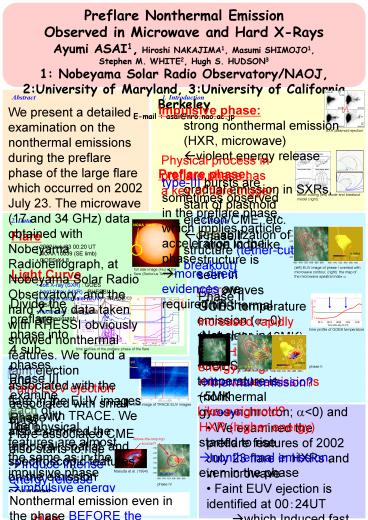2' Data - PowerPoint PPT Presentation
1 / 1
Title:
2' Data
Description:
... Microwave and Hard X-Rays. Ayumi ASAI1, Hiroshi NAKAJIMA1, Masumi SHIMOJO1, Stephen M. WHITE2, Hugh ... 1: Nobeyama Solar Radio Observatory/NAOJ, 2:University of ... – PowerPoint PPT presentation
Number of Views:34
Avg rating:3.0/5.0
Title: 2' Data
1
Preflare Nonthermal Emission Observed in
Microwave and Hard X-Rays Ayumi ASAI1, Hiroshi
NAKAJIMA1, Masumi SHIMOJO1, Stephen M. WHITE2,
Hugh S. HUDSON3 1 Nobeyama Solar Radio
Observatory/NAOJ, 2University of Maryland,
3University of California Berkeley E-mail
asai_at_nro.nao.ac.jp
Abstract
1. Introduction
Impulsive phase strong nonthermal emission (HXR,
microwave) ?violent energy release Preflare
phase gradual emission in SXRs, start of
plasmoid ejection/CME, etc. ?destabilization of
the structure (tether-cutting / breakout)
We present a detailed examination on the
nonthermal emissions during the preflare phase of
the large flare which occurred on 2002 July 23.
The microwave (17 and 34 GHz) data obtained with
Nobeyama Radioheliograph, at Nobeyama Solar Radio
Observatory, and the hard X-ray data taken with
RHESSI obviously showed nonthermal features. We
found a faint ejection associated with the flare
in the EUV images taken with TRACE. We also
examined the temporal, spatial, and spectroscopic
features on the emission sources.
SXR plasmoid ejection
Physical process in preflare phase has a key of
flare trigger
type-III bursts are sometimes observed in the
preflare phase, which implies particle
acceleration in the phase ?more direct evidences
are required (?)
tether-cutting (left) mode and breakout model
(right)
2. Data
3. Results
NOAA 10039
Phase I
- Flare
- 2002/July/23 0020 UT
- NOAA 10039 (SE limb)
- GOES X4.8
- Light Curve
- soft X-ray (SXR) GOES
- hard X-ray (HXR) RHESSI
- extreme ultraviolet (EUV) TRACE (195Å)
- microwave Nobeyama Radioheoigraph
- Large loop-like structure is seen in microwaves
- Thin-thermal emission (a0)
- Not clear in EUV
- GOES temperature is 5MK
- Like a sigmoid?
(left) EUV image of phase I overlaid with
microwave contour, (right) the map of the
microwave speatral index a
full disk image (Ha) of the flare (Sartorius
Telescope)
Phase II
GOES
Divide the preflare phase into 4 sub-phases, and
examine each of them
GOES temperature increased rapidly (hotter than
10MK) SXR/HXR (low energy) brightened ?thermal
emission?
NoRH
RHESSI
time profile of GOES temperature
time profiles of the preflare phase of the flare
phase II
Phase III
micorwave emissions (nonthermal gyrosynchrotron
alt0) and HXR (higher energy) started to
rise ?nonthermal emission, even in the phase
Faint EUV ejection associated with small
burst Flare-associated CME also starts to
rise ?Induce intense energy release
time slice image of TRACE EUV images
5. Summary
Phase IV
The physical features are almost the same as in
the impulsive phase ?impulsive energy
release HXR Footpoint (nonthermal) Above-the-loop-
top (thermal?/nonthermal?) microwave Loop / loop
top (nonthermal)
- We examined the preflare features of 2002 July
23 flare in HXRs and in microwave - Faint EUV ejection is identified at 0024UT
- ?which Induced fast energy release in the
impulsive phase - We found the thermal and nonthermal features
even in the phase before the ejection - Nonthermal emission _at_ footpoint and loop top
- Masudas HXR sources?
- ?Energy release mechanism in the preflare phase
is probably accompanied by particle acceleration
Above-the-loop-top source!?
Masuda et al. (1994)
phase IV
Nonthermal emission even in the phase BEFORE the
ejection (phase II) ?Destabilization process is
accompanied by particle acceleration































